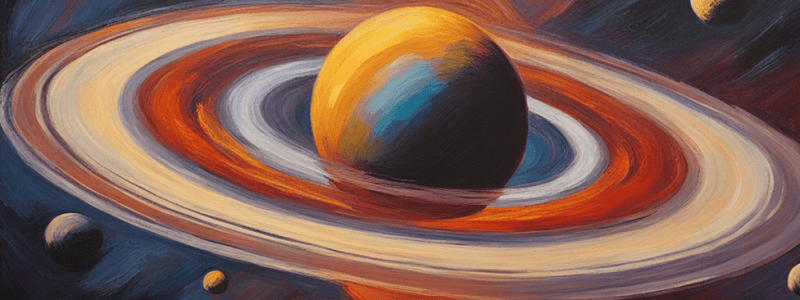Podcast
Questions and Answers
What is the primary composition of Saturn's rings?
What is the primary composition of Saturn's rings?
- Silicate minerals
- Carbon dioxide
- Water ice (correct)
- Helium
What is the most prominent feature of Saturn visible even through small telescopes?
What is the most prominent feature of Saturn visible even through small telescopes?
- Atmospheric dance
- Moonlets
- Surface cradling moons
- Ring system (correct)
Which moon is NOT mentioned as part of Saturn's moons in the text?
Which moon is NOT mentioned as part of Saturn's moons in the text?
- Europa (correct)
- Mimas
- Titan
- Callisto
What characteristic of Saturn's rings defies conventional logic according to the text?
What characteristic of Saturn's rings defies conventional logic according to the text?
What is the primary composition of Saturn itself, excluding its rings?
What is the primary composition of Saturn itself, excluding its rings?
What type of missions have explored Saturn according to the text?
What type of missions have explored Saturn according to the text?
Which moon of Saturn is known for its thick orange smog?
Which moon of Saturn is known for its thick orange smog?
What gives Saturn's atmosphere a blue cast according to the text?
What gives Saturn's atmosphere a blue cast according to the text?
Which moon of Saturn is home to astounding mountain ranges reaching over 20 km high?
Which moon of Saturn is home to astounding mountain ranges reaching over 20 km high?
Which gas dominates Saturn as a gas giant, besides hydrogen?
Which gas dominates Saturn as a gas giant, besides hydrogen?
Flashcards are hidden until you start studying
Study Notes
Saturn's Enchanting Wonders
Imagine a planet shrouded by mysterious rings, its surface cradling a stunning variety of moons, and enveloped by a unique atmospheric dance—this celestial body is none other than Saturn. Let's delve into this enthralling world, exploring everything from its iconic ring system to its fascinating moonlets and intrepid explorations.
Rings
The most prominent feature of Saturn, visible even through small telescopes, is its breathtaking set of rings composed primarily of ice particles ranging from dust-sized specks to chunks several meters across. These strands of cosmic beauty sprawl outward from the equator, appearing vividly when viewed edge-on during Saturnian summers. Made up of myriad individual bands like Cassini, B, C, and D, these captivating formations defy conventional logic due to their unwaveringly flat orientation despite ongoing interactions with countless satellites and debris.
Composition
While Saturn itself is a gas giant predominantly formed of hydrogen and helium in its lower layers, its captivating rings consist mainly of water ice, along with trace amounts of organics such as methane, ammonia, and carbon dioxide. Additionally, scientists have detected tiny dust grains made of silicate minerals lodged amidst the larger bits of frozen water. This intriguing mix contributes to the mesmerizing kaleidoscope we see in space.
Exploration Missions
Investigation of Saturn began in earnest in the mid-twentieth century using ground-based observational techniques followed closely by multiple successful robotic expeditions. Notable among them are NASA’s Pioneer 11 and Voyager 1&2 mission launches between 1972 and 1978, which sent back significant data about the ring system and confirmed Saturn’s extensive complement of moons. However, it was the Cassini–Huygens mission launched in 1997 that truly illuminated the previously elusive secrets of Saturn. From 2004 until September 15, 2017, Cassini orbited Saturn and provided an unprecedented wealth of information about the entire Saturnian system.
Moons
Beyond the hypnotic splendor of the rings lie the bewitching realm of Saturn's more than sixty known moons. While some measure only a few hundred meters across, others rival Earth's Moon in size, showcasing diverse geologic features. Some popular examples include Titan, the solar system's second largest moon, renowned for its thick orange smog; Iapetus, home to astounding mountain ranges reaching over 20 km high; and Enceladus, whose poles harbor active cryovolcanism, spouting plumes of water vapor and icy particles. On top of this cosmopolitan collection lies Ganymede, a moonlet discovered in 2004 that may reside within the A ring.
Atmosphere
Despite being a gas giant dominated by hydrogen and helium, Saturn also hosts a considerable quantity of methane, a reddish molecule that offers absorptive properties responsible for the blue cast observed in the planetary atmosphere. As if painted with acrylic strokes, these colors contrast beautifully against the white ice rings surrounding the planet, making it appear almost dreamlike against the blackness of space. Moreover, Saturn has winds rivaling those of our own planet, producing cloud patterns shaped like hexagons on its north pole.
As you can now appreciate, Saturn remains one of the most alluring wonders of our universe, offering a captivating tapestry of sights and mysteries waiting to be explored further. Its rings, compositional qualities, history of exploration, plethora of moons, and atmospheric phenomena continue to inspire astronomers and thrill enthusiasts alike, ensuring that Saturn will remain a cherished muse for generations to come.
Studying That Suits You
Use AI to generate personalized quizzes and flashcards to suit your learning preferences.




